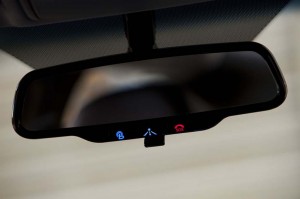
As with some competitors, you'll be able to activate many Hyundai Blue Link features using buttons on the rearview mirror.
Forget horsepower, cupholders or even seat heaters. These days, the real battle of the brands is focused on which automaker offers the most advanced infotainment system, and there’ll be plenty of new in-car technologies on display, this week, at the annual Consumer Electronics Show, in Las Vegas.
That includes Blue Link, an all-new telematics system developed by Hyundai, which the automaker plans to put up against the well-established General Motors OnStar, as well as Ford’s increasingly popular Sync system.
 The Hyundai Blue Link platform will offer a variety of “traditional” features, such as hands-free calling and voice-controlled route guidance. But it will also introduce a number of new services, such as its “Eco-Coach,” which is designed to help a motorist drive more fuel-efficiently, and “geofence,” which alerts a vehicle’s owner if someone – read “a teenager” – travels beyond a pre-set boundary or drives after set hours.
The Hyundai Blue Link platform will offer a variety of “traditional” features, such as hands-free calling and voice-controlled route guidance. But it will also introduce a number of new services, such as its “Eco-Coach,” which is designed to help a motorist drive more fuel-efficiently, and “geofence,” which alerts a vehicle’s owner if someone – read “a teenager” – travels beyond a pre-set boundary or drives after set hours.
Blue Link will even flash a warning if the owner’s vehicle is subject to a recall.
“We’ve carefully studied how drivers rely on smart phones and navigation systems as an innovative link to the outside world. Blue Link brings that seamless connectivity directly into the car,” explains Barry Ratzlaff, director of customer satisfaction and service business development, Hyundai Motor America.
The Korean maker claims there will be 30 “unique” connectivity features offered on Blue Link, when it launches on the Sonata sedan and the all-new Veloster later this year. Experts might quibble over the precise number but it’s clear that Hyundai hopes to offer at least some truly distinct features as well as some of the more popular services already available through such competitors as OnStar and Sync.
While it’s difficult to say precisely how important such services are, industry experts believe that today’s increasingly tech-savvy motorists are being swayed by the available of advanced infotainment services – and may choose one of the cars on their shopping list if it offers the better technology.
On the other hand, there’s also been something of a backlash, federal regulators among those sounding the alarm about the potential for distracted driving. Earlier this week, Consumer Reports magazine denied a coveted “Buy” recommendation to two Ford products using the maker’s new MyTouch technology because, the publication declared, the system is “overly complicated and distracting.” (Click Here for the full story.)
That has led makers to not only add more features but also to find ways to simplify the operation of systems like Blue Link.
The Hyundai system is a bit of a hybrid between subscription-based services, such as OnStar, and others, like Sync, that charge up-front for hardware but which are then free to use. Much of the new Hyundai package will not require a monthly (or annual fee), but some features will have a price tag once an initial test period is concluded.
As with OnStar, the primary pay services will focus on safety and security issues, dubbed Blue Link Assurance, which will be able to automatically notify emergency rescue crews in the event of a crash that might otherwise disable the driver and passengers. Roadside assistance will also be provided as part of the Assurance package.
Additionally, Blue Link will be able to sound an automatic warning if a vehicle has been stolen, then help authorities track the vehicle. They can even get it to slow down or stop automatically by remote control.
Like other players in the Telematics field, Hyundai is adopting a more open architecture design for Blue Link – more in line with the consumer electronics field than with conventional automotive engineering. While the system won’t be as open to outside developers as an Apple iPhone, Hyundai – and many of its competitors – are turning to outside partners to encourage them to rapidly develop new functionality.
Ford and GM, among others, are planning to announce a number of new features during the annual CES confab, this week. (For more on OnStar’s big announcements, Click Here.)
One or the more intriguing options on Blue Link will allow a parent to set specific rules for a teenage driver – such as when and where the vehicle can be operated. If the teen wanders further than permitted, or operates the vehicle beyond curfew, the system will immediately advise the owner by sending a text message to their smartphone.
Hyundai believes that by advising owners about service issues, it can also increase by 40% the use of its dealers’ service bays.
Following the initial launch on Sonata and Veloster, Hyundai expects Blue Link to migrate into most of its products by the 2013 model-year.
